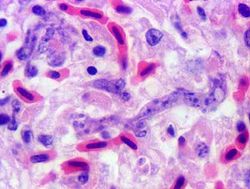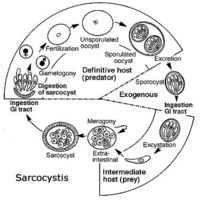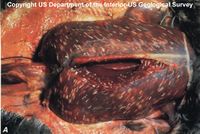Sarcocystis: Difference between revisions
No edit summary |
|||
| Line 17: | Line 17: | ||
{| width="300" | {| width="300" | ||
| height="10" bgcolor="#FFDF95" | | | height="10" bgcolor="#FFDF95" | | ||
'''NCBI: [http://www.ncbi.nlm.nih.gov/Taxonomy/Browser/wwwtax.cgi?id= | '''NCBI: [http://www.ncbi.nlm.nih.gov/Taxonomy/Browser/wwwtax.cgi?mode=Undef&id=5812&lvl=3&keep=1&srchmode=1&unlock Taxonomy] Genome''' | ||
|} | |} | ||
Revision as of 19:37, 22 August 2006
A Microbial Biorealm page on the genus Sarcocystis

Classification
Higher order taxa
Eukaryota; Alveolata; Apicomplexa; Coccidia; Eimeriida; Sarcocystidae
Species
Sarcocystis cruzi
Sarcocystis rileyi
Sarcocystis neurona
|
NCBI: Taxonomy Genome |
Description and Significance
Sarcocystis is a genus of parasites which affects a number of animals, both wild and domesticated. Members of Sarcocystis have two life cycles: one in the intermediate host (an herbivore such as a duck or rodent) and one in the definitive host (a carnviore such as a dog or wolf). The most common species is Sarcocystis rileyi, which causes the disease known as "rice breast disease" in waterfowl. Hunters who slice open infected animals may see small, white, cylindrical cysts in the breast and other muscles. Only in rare cases is the animal affected by the parasite; on these occasions they may cause weakness or lameness in mucles and limbs. In some areas of the world the species Sarcocystis cruzi infects a great number of pigs, sheep, and cattle. Luckily Sarcocystis demonstrates little or no risk to humans; the cysts are killed off when the meat is cooked. If the cysts are ingested, most commonly through undercooked infected meat, they may cause mild diarrhea or muscle tenderness. A more serious illness in horses, caused by Sarcocystis neurona is Equine Protozoal Myeloencephalitis (EPM).
Genome Structure
Two of Sarcocystis' surface proteins, Sn14 and Sn16, have shown to be factors in the infection and immunity of Sarcocystis neurona in horses. Use of these proteins in vaccines may prevent the attachment and penetration of host cells.
Cell Structure and Metabolism

Sarcocystis' parasitic cells are like those of all apicomplexans: they lack flagella and cilia, infecting the host cells by way of an organelle called the apicoplast (see Apicomplexa). Birds and other invertebrates consume the parasite in egg or oocyst form from the feces of infected vertebrates; the oocysts then develop into the sporozoite form in the intestines of the invertebrate. The sporozoites migrate to the animal's bloodstream and invade certain cells, which are then multiplied and give rise to the next form, the merozoite. These merozoites are carried by the blood to the animal's muscles, where whitish macrocysts are produced. When carnivores eat the invertebrate's muscle tissue, the parasites reach maturity and reproduce sexually in the host's intestine, releasing oocysts. In horses infected with Sarcocystis neurona, the sporozoites enter the endothelial cells and replicate asexually, developing into tachyzoites, which then migrate to the animal's central nervous system. Here they slowly replicate and gradually take over the nervous system, leading to clinical signs in the infected animal such as limb weakness, incoordination, and gait inconsistencies.
Ecology
Sarcocysts are parasites which live in a number of hosts; therefore their distribution is wide and varied. They infect animals worldwide: North America, Australia, South Africa. So far Sarcocystis has not demonstrated a profound impact on its enivronment, but as of yet little is still known of this parasite and the diseases it causes. For this reason humans are discouraged from eating infected meat or feeding it to domesticated animals, but consumption has not been harmful or fatal. Controlling the parasite would involve disrupting its life cycle, but because it has not proved to be dangerous, such measures have not and probably will not be taken.

References
Liang, Ting Fang et al. Evidence that Surface Proteins Sn14 and Sn16 of Sarcocystis neurona Merozoites Are Involved in Infection and Immunity. Abstract. Infection and Immunity. v66(5) May 1998. 1834-1838.
McCormick-Rantze, Mavis L., et al. Sarcocystosis in Psittacine Birds. College of Veterinary Medicine, University of Georgia.
Sarcocystis. Department of Natural Resources. Michigan.gov. Updated 2005.
Sarcocystis spp. Parasites and Parasitological Resources. College of Biological Sciences, Ohio State University.
Sarcocystis in Alberta. Sustainable Resource Development. Government of Alberta. Updated November 9 2004.
Equine Protozoal Myeloencephalitis. Our World. Last updated January 29 2000.
Tuggle, Benjamin N., et al. Sarcocystis. Field Manual of Wildlife Diseases: Birds. National Wildlife Health Center. Last modified August 27 2004.
Wiser, Mark F. Sarcocystis. Medical Protozoology. Tulane University School of Public Health. Updated January 26 2004.
